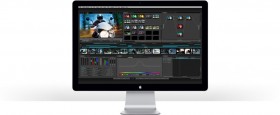At IBC 2011, I met with Dan May, President of Blackmagic Design to find out how their products can help cinematographers, camera crews and the usual suspects who read FDTimes. Dan runs the U.S., North America and South America office. Dan joined Blackmagic five years ago when they needed a local office in the U.S. Previously, Blackmagic was all in Australia. The company has grown rapidly, with offices in Europe, Singapore, Japan, and distributors worldwide. The US office is in Milpitas, the San Jose Bay Area.
Before Blackmagic, Dan May was with Canopus. Then he worked for a video start-up, in the feature and broadcast areas. He spent many years in sales and strategy and building up the businesses. When Blackmagic knew they wanted to come to the U.S. and wanted to start an office, they knew they wanted it in the Bay Area to be close to Apple, Adobe and their partners. For Dan, it was a good timing and he was in the right place at the right time.
FDTimes: What do our devoted readers — mainly cinematographers, directors, producers–need to know about Blackmagic?
Dan May: There are a lot of things that Blackmagic does. A lot of people are familiar with our Capture Cards, which is where we started, doing input and output devices. Over the past few years , we’ve expanded into many different territories. We have mini converters. We have routers. We have live production switchers. We have new Thunderbolt products. We’ve got acquisitions like the switchers and the DaVinci software. A lot of people know us from the color grading software.
So, we’ve really expanded to be more than just a one-trick pony. We’ve got a lot of different categories of products that are out there. What a camera technician might want would be solid state disc recorders for field recording. A cinematographer might like to know more about our DeVinci Resolve side of things. And, an editor would like our capture cards and postproduction products. We fill in a lot of the gaps throughout the entire production and post process. We’re not maybe going to be the entire workflow, but in getting from point A to point Z, we have many products that fit in.
Q: I think one of the things I’m most excited by is the DaVinci on a laptop. Davinci Resolve (picture at top).
A: Being able to sit down with a software version that, a few years ago, would have cost you a half a million dollars, now you can say, “Look, for a thousand dollars, I’ve got the full-fledged software.” At the show we announced compatibility on Windows. We had it on the Mac two years ago.
At NAB 2011 we launched our Lite version, which is a free version of the DaVinci software. It has some restrictions: only two nodes, and not being able to do some of the higher-end 2K or 3-D type of features. But it’s a full-featured software that you can start using. It’s for people who say, “I’ve been interested in color grading. But I don’t want to invest yet, because I’d like to try it out first.”
We want people to be able to download the software, start working with it, see what they can do, the potential that it has, what can be unlocked. And, as they use it, they’ll eventually, we believe, come to a point where, when you’re sitting down with a client, you are going to want that full version to be able to access the other features. But the free version is quite robust in what it gives you. And I can do it on a Mac. I can do it on an iMac. I can do it on a laptop. It’s quite powerful.
Q: I think for almost every DP, the idea is this is the tool we’ve been sitting in a room with, and telling the colorist, “Okay, more of this.” And now we can try it out ourselves, and learn how to communicate even better. We can also work on the look and send it to the colorist as a guideline.
A: Right. You know, the great part with the free version is you can be on set, lining up things, showing what the shots look like. And you don’t necessarily have to have tons of real time performance. And those same things can be brought over to the full stations that now have multiple GPUs. They can be done with the colorist that you’re paying the big bucks to finalize everything for you. And you’re not limited into saying, “Well, I hope this looks okay by the time we go to the expensive grading suite.”
Q: Let’s say you’re shooting in ARRI Alexa RAW. What’s your workflow?
A: It’s a very easy thing to do. You basically are bringing those files directly over. That’s the beauty of it. You’re opening up the files. And you just start color grading. Even on the free version, I can just be on a laptop, drag those files over, open them up, create the look and save it. You’re basically just saving a file, which you can email or send in.
If I want to take that over to my color grading suite, they can import all of that and begin to work off of those files in earnest. But now you have real time performance because the grading suite has four GPU cards there and the power to do all the real time grading there.
Q: How does your colorist know that they have the same look-ups and color management that you do?
A: It’s all project-driven. If I’m saying, “Look, this is my IBC 2011 project,” you’re saving that project. And it’s saving all those looks and presets. If I now take those files and I fly back to the U.S. from Amsterdam, when I open up that same IBC project, it’s got all that data stored in there for me.
Q: And the HyperDeck that we saw at NAB is shipping now?
A: The HyperDeck Shuttle started shipping about three weeks ago. Those are the field recorder versions. And the HyperDeck Studios, which are rack-mountable like a “VTR” just started shipping this last week.
Q: Tell me more about the Studio version?
A: The Studio version has the two SSDs, has deck control, has loop-through. It feels more like a VTR. It can obviously be used as many different things, but it feels more like a VTR.
Q: And what are we looking at for the future?
A: We’re deep in discussions with all of our partners about what they are wanting to do. Apple, Adobe and Avid have announced a lot of great things and we want to be working with partners who are looking forward. We’ve been a long-time partner with Apple.
Blackmagic is going to continue to work hard to keep releasing fantastic products that are empowering to people and production. I expect a short five-months from now, when we’re at NAB, we’ll see more creative and empowering products.










